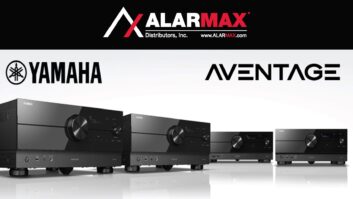The Bluetooth and IEEE 802.11b HR wireless-network standards will begin turning up next year in consumer electronics products as a result of progress in enhancing the standards, proponents say.
The enhancements will add streaming audio support to the Bluetooth spec, and streaming audio and video support to 802.11b, preventing dropouts that would be caused when digital data packets collide or when available bandwidth is filled up.
In one of two developments, Philips Components of Sunnyvale, Calif., announced that it is working with Bang & Olufsen to supply a Bluetooth module for wireless speakers due by early 2002. B & O declined to say whether the product would be available in the United States at that time.
The Philips module will be based on an updated Bluetooth 1.1 spec that will add support for one compressed stereo music stream at a data rate up to 128 Kbps, said Lauri Klomp, worldwide director of sales and marketing for wireless connectivity at Philips Components. The update will be finalized in the mid second half of this year, she said. Future updates will add streaming-video support.
The completed spec will “define the wireless specifications for Bluetooth-based hi-fi audio and video applications to seamlessly connect with each other,” according to a Philips statement.
Bluetooth’s data rate is 720 Kbps, Klomp noted. Uncompressed CD audio, in contrast, requires a peak data rate of 1.5MBps. An MPEG-1 (VHS-quality) video requires 1-3MBps.
In a separate 802.11b announcement, semiconductor supplier ShareWave, El Dorado Hills, Calif., said it will offer its Whitecap technology royalty-free for use in an optional IEEE standard, dubbed 802.11e. The new standard would make 802.11b HR and its higher-speed IEEE counterparts suitable for distributing audio and video throughout a house.
The optional standard, expected to be finalized later this year or early next, could also be applied to the higher-speed IEEE 802.11a and 802.11g wireless standards, said ShareWave corporate development VP Bob Bennett.
Whitecap’s TDMA (Time Division Multiple Access) technology dynamically adjusts the size of the slots so “a video stream gets what it needs and a print job gets whatever is left,” said Bennett.
IEEE 802.11e adds multimedia and QoS support, plus security enhancements, to the existing IEEE 802.11 family, designed originally for enterprise LANs. As a result, a ShareWave statement said, IEEE 802.11e “creates a universal wireless standard for the home, enterprise and public environments, such as airports or hotels.” It would be “the first wireless standard that spans both home and business environments,” said ShareWave.
The 802.11e standard, the company said, “will lay the groundwork for consumer electronics companies to offer a variety of new wireless LAN products for the home, including networked digital set-top boxes, personal video recorders, residential gateways, mobile Web pads, wireless MP3 players, and digital audio and video jukeboxes.”
ShareWave also foresees service providers using the technologies to offer new home services such as video-on-demand, high-speed Internet sharing and Voice over IP.
“This is a watershed development that can hasten the implementation of multimedia-capable wireless home networks and provide an important link for the cable industry to transmit new digital content and services to the home,” said Steve Craddock, Comcast’s senior VP of new media.
The 802.11b HR standard operates in the 2.4GHz band at an 11MBps data rate, delivering 6MBps throughput that could support several simultaneous streams of uncompressed CD audio (at up to 1.5MBps each), or several MPEG-1 (VHS-quality) videostreams at 1-3MBps, Bennett said. It could also support one standard-definition digital TV program (from digital cable or a satellite system) at an average data rate of 4-4.5MBps with a peak of 6MBps for high-action programs.
The 802.11a standard will deliver even more capabilities, with a gross data rate of 54MBps and an effective throughout of about 32-38MBps. That’s enough for about three simultaneous MPEG-2 DVD streams, each requiring approximately 5MBps to a peak 12MBps for high-action programs, said Bennett. It’s also enough for one to perhaps two simultaneous HDTV streams at 18-20MBps each.
“Most of the market momentum is behind 802.11b moving to 802.11a,” Bennett noted. The planned 802.11g standard, previously called 802.11b HRb by some marketers, operates at 2.4GHz at a gross data rate of 22MBps, delivering throughout of about 15MBps at distances up to about 125 feet, with throughput falling at longer distances.
Home computer-networking products, residential Internet gateways and wireless Web pads incorporating 802.11b HR and proprietary QoS technologies, including Whitecap, are already becoming available from some companies. But in more mainstream A/V products such as set-top boxes, he said, 802.11b HR could begin appearing late this year and “definitely” in 2002.
The first set-top boxes, some of which might include hard drives for storing audio and video, will become the “distribution mechanism for content in the home” and will initially be marketed by cable and satellite companies, he said. Some of the first products will appear with and without the 802.11e enhancement, depending on how far along the products are in development at the time the 802.11e spec is approved.
The first 802.11a products, without the 802.11e enhancement, will be available to consumers in the second half and will likely be designed for computer networking in the enterprise or home, he said.
Bennett wasn’t certain when 802.11g would be finalized or when products incorporating it would be available.













